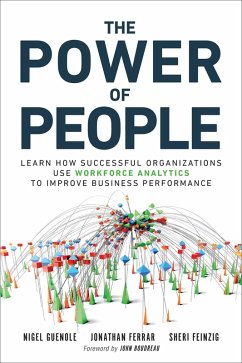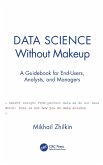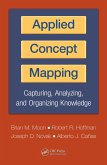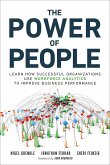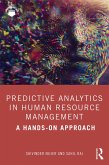Power of People, The (eBook, PDF)
How Successful Organizations Use Workforce Analytics To Improve Business Performance


Alle Infos zum eBook verschenken

Power of People, The (eBook, PDF)
How Successful Organizations Use Workforce Analytics To Improve Business Performance
- Format: PDF
- Merkliste
- Auf die Merkliste
- Bewerten Bewerten
- Teilen
- Produkt teilen
- Produkterinnerung
- Produkterinnerung

Hier können Sie sich einloggen

Bitte loggen Sie sich zunächst in Ihr Kundenkonto ein oder registrieren Sie sich bei bücher.de, um das eBook-Abo tolino select nutzen zu können.
Learn from Today's Most Successful Workforce Analytics Leaders Transforming the immense potential of workforce analytics into reality isn't easy. Pioneering practitioners have learned crucial lessons that can help you succeed. The Power of People shares their journeys-and their indispensable insights. Drawing on incisive case studies and vignettes, three experts help you bring purpose and clarity to any workforce analytics project, with robust research design and analysis to get reliable insights. They reveal where to start, where to find stakeholder support, and how to earn "quick wins" to…mehr
- Geräte: PC
- ohne Kopierschutz
- eBook Hilfe
- Größe: 6.29MB
![Data Science Without Makeup (eBook, PDF) Data Science Without Makeup (eBook, PDF)]() Mikhail ZhilkinData Science Without Makeup (eBook, PDF)26,95 €
Mikhail ZhilkinData Science Without Makeup (eBook, PDF)26,95 €![Applied Concept Mapping (eBook, PDF) Applied Concept Mapping (eBook, PDF)]() Applied Concept Mapping (eBook, PDF)78,95 €
Applied Concept Mapping (eBook, PDF)78,95 €![Power of People, The (eBook, ePUB) Power of People, The (eBook, ePUB)]() Nigel GuenolePower of People, The (eBook, ePUB)11,95 €
Nigel GuenolePower of People, The (eBook, ePUB)11,95 €![e-HRM (eBook, PDF) e-HRM (eBook, PDF)]() e-HRM (eBook, PDF)49,95 €
e-HRM (eBook, PDF)49,95 €![Predictive Analytics in Human Resource Management (eBook, PDF) Predictive Analytics in Human Resource Management (eBook, PDF)]() Shivinder NijjerPredictive Analytics in Human Resource Management (eBook, PDF)50,95 €
Shivinder NijjerPredictive Analytics in Human Resource Management (eBook, PDF)50,95 €![Intelligent Human Systems Integration (eBook, PDF) Intelligent Human Systems Integration (eBook, PDF)]() Intelligent Human Systems Integration (eBook, PDF)233,95 €
Intelligent Human Systems Integration (eBook, PDF)233,95 €![Phoenix Leadership for Business (eBook, PDF) Phoenix Leadership for Business (eBook, PDF)]() Valentina GokenbachPhoenix Leadership for Business (eBook, PDF)34,95 €
Valentina GokenbachPhoenix Leadership for Business (eBook, PDF)34,95 €-
-
-
Dieser Download kann aus rechtlichen Gründen nur mit Rechnungsadresse in A, B, BG, CY, CZ, D, DK, EW, E, FIN, F, GR, HR, H, IRL, I, LT, L, LR, M, NL, PL, P, R, S, SLO, SK ausgeliefert werden.
- Produktdetails
- Verlag: Pearson ITP
- Seitenzahl: 352
- Altersempfehlung: ab 18 Jahre
- Erscheinungstermin: 19. Mai 2017
- Englisch
- ISBN-13: 9780134544519
- Artikelnr.: 48420364
- Verlag: Pearson ITP
- Seitenzahl: 352
- Altersempfehlung: ab 18 Jahre
- Erscheinungstermin: 19. Mai 2017
- Englisch
- ISBN-13: 9780134544519
- Artikelnr.: 48420364
- Herstellerkennzeichnung Die Herstellerinformationen sind derzeit nicht verfügbar.
Jonathan Ferrar is a respected consultant, speaker, and influencer in HR strategy, workforce analytics, and the future of work. He advises clients on how to establish human resources strategies that will improve business performance and make HR more relevant. He was listed as one of the global Top 50 HR Analytics Influencers on LinkedIn in 2014 and as one of the 15 HR and People Analytics Experts to Follow for 2017 by Jibe. Before he started his own consultancy business, Jonathan worked for more than 25 years in corporate business in IBM, Andersen Consulting (now Accenture), and Lloyds Bank, for many of those years in senior executive management roles in both the United Kingdom and the United States. Jonathan has worked with C-suite clients and business leaders across the globe on human resources management and workforce analytics. He holds a bachelor of arts degree and a master of arts degree from the University of Cambridge and a postgraduate diploma in human resources management from Kingston Business School. He is a Chartered Fellow of the Chartered Institute of Personnel and Development (Chartered FCIPD).
Sheri Feinzig is a director at IBM, where she leads a global team of consultants, content development experts, and the Smarter Workforce Institute. Sheri has more than 20 years of experience in human resources research, organizational change management, and business transformation. She has applied her analytical and methodological expertise to numerous research-based projects on topics such as employee retention, employee engagement, performance feedback, social network analysis, and organizational culture. Sheri received her Ph.D. in Industrial-Organizational Psychology from the University at Albany, State University of New York. She has presented on numerous occasions at national conferences and has coauthored a number of publications and white papers. She has served as an adjunct professor in the psychology departments of Rensselaer Polytechnic Institute in Troy, New York, and the Illinois Institute of Technology in Chicago, Illinois, where she taught doctoral, masters, and undergraduate courses on performance appraisal, tests, and measures. Sheri is a member of the Society for Industrial and Organizational Psychology (SIOP).
About the Authors xix
Interviewees xxi
Vignettes xxv
Preface xxvii
PART I: UNDERSTANDING THE FUNDAMENTALS 1
Chapter 1 Why Workforce Analytics? 3
Adoption of Analytics 4
HR’s Contribution to Business Value 4
The Changing Nature of HR 7
The Future of Work 11
Summary 13
Chapter 2 What’s in a Name? 15
Focus of the Function 16
Activities of the Function 17
A Name Fit for the Future 18
Summary 18
Chapter 3 The Workforce Analytics Leader 19
Reporting to the Chief Human Resources Officer 20
Responsibilities of the Workforce Analytics Leader 20
Business Acumen 22
Leadership Attributes 23
Summary 26
Chapter 4 Purposeful Analytics 27
A Model for Purposeful Analytics 28
Project Sponsors 38
Why Do Analytics Projects Fail? 40
Summary 42
Chapter 5 Basics of Data Analysis 43
Research Design 44
Objectives of Analysis 47
Unstructured Data 52
Traditional Statistics versus Machine Learning 53
Social Consequences of Algorithms 54
More on Design and Analysis 56
Summary 56
Chapter 6 Case Studies 57
Eight-Step Methodology 58
Case Study: Improving Careers Through Retention Analytics at Nielsen 59
Case Study: From Employee Engagement to Profitability at ISS Group 65
Case Study: Growing Sales Using Workforce Analytics at Rentokil Initial
71
Case Study: Increasing Value to the Taxpayer at the Metropolitan Police
76
Case Study: Predictive Analytics Improves Employee Well-Being at
Westpac 80
Summary 83
PART II: GETTING STARTED 85
Chapter 7 Set Your Direction 87
You Have the Job! Now What? 88
Listening to Prospective Project Sponsors 90
The Seven Forces of Demand 91
Agreeing on the Scope of Analytics 95
Developing a Vision and Mission Statement 95
Summary 97
Chapter 8 Engage with Stakeholders 99
Who Are Stakeholders? 100
Stakeholders Served 101
Stakeholders Depended Upon 106
Stakeholders Impacted 113
Working Effectively with Stakeholders 118
Summary 121
Chapter 9 Get a Quick Win 123
Identifying Potential Projects 125
Complexity-Impact Matrix 125
Assessing Complexity and Impact 129
Summary 133
PART III: BUILDING YOUR CAPABILITY 135
Chapter 10 Know Your Data 137
A Pragmatic View of Data 138
Solving Data Quality Challenges 138
Data Types and Sources 147
Data Governance 152
Remember the Basics 152
Summary 155
Chapter 11 Know Your Technology 157
Starting with Vision and Mission 158
Components of Workforce Analytics Technology 159
On-Premise Versus Cloud 164
Technology Vendor Relationships 165
Summary 167
Chapter 12 Build the Analytics Team 169
Six Skills for Success 170
Configuring Team Roles 181
Remember the Fundamentals! 184
Summary 185
Chapter 13 Partner for Skills 187
Why Consider Partners? 188
Options for Building the Team 188
Choosing Among the Options 197
Summary 200
Chapter 14 Establish an Operating Model 203
Defining Your Operating Model 204
Strategy 205
Governance 205
Implementation 212
Accountability 221
Summary 224
PART IV: ESTABLISHING AN ANALYTICS CULTURE 225
Chapter 15 Enable Analytical Thinking 227
Perspectives of Analytics in HR 228
The Translator Role 234
The Importance of Leadership 236
Summary 237
Chapter 16 Overcome Resistance 239
Resistance to Workforce Analytics 240
Stakeholder Skepticism 240
Financial Frugality 245
HR Hesitancy 246
Summary 252
Chapter 17 Communicate with Storytelling and Visualization 253
What Is Storytelling? 254
Effective Visualization 263
Knowing Your Audience 269
Keeping It Simple 273
Summary 275
Chapter 18 The Road Ahead 277
Analytics Provides New Opportunities for HR 278
Emerging Data Sources 278
Considering New Data Sources 280
Evolving Technology 282
The Workforce Analytics Function 283
Summary 286
Glossary 287
References 295
Index 301
About the Authors xix
Interviewees xxi
Vignettes xxv
Preface xxvii
PART I: UNDERSTANDING THE FUNDAMENTALS 1
Chapter 1 Why Workforce Analytics? 3
Adoption of Analytics 4
HR’s Contribution to Business Value 4
The Changing Nature of HR 7
The Future of Work 11
Summary 13
Chapter 2 What’s in a Name? 15
Focus of the Function 16
Activities of the Function 17
A Name Fit for the Future 18
Summary 18
Chapter 3 The Workforce Analytics Leader 19
Reporting to the Chief Human Resources Officer 20
Responsibilities of the Workforce Analytics Leader 20
Business Acumen 22
Leadership Attributes 23
Summary 26
Chapter 4 Purposeful Analytics 27
A Model for Purposeful Analytics 28
Project Sponsors 38
Why Do Analytics Projects Fail? 40
Summary 42
Chapter 5 Basics of Data Analysis 43
Research Design 44
Objectives of Analysis 47
Unstructured Data 52
Traditional Statistics versus Machine Learning 53
Social Consequences of Algorithms 54
More on Design and Analysis 56
Summary 56
Chapter 6 Case Studies 57
Eight-Step Methodology 58
Case Study: Improving Careers Through Retention Analytics at Nielsen 59
Case Study: From Employee Engagement to Profitability at ISS Group 65
Case Study: Growing Sales Using Workforce Analytics at Rentokil Initial
71
Case Study: Increasing Value to the Taxpayer at the Metropolitan Police
76
Case Study: Predictive Analytics Improves Employee Well-Being at
Westpac 80
Summary 83
PART II: GETTING STARTED 85
Chapter 7 Set Your Direction 87
You Have the Job! Now What? 88
Listening to Prospective Project Sponsors 90
The Seven Forces of Demand 91
Agreeing on the Scope of Analytics 95
Developing a Vision and Mission Statement 95
Summary 97
Chapter 8 Engage with Stakeholders 99
Who Are Stakeholders? 100
Stakeholders Served 101
Stakeholders Depended Upon 106
Stakeholders Impacted 113
Working Effectively with Stakeholders 118
Summary 121
Chapter 9 Get a Quick Win 123
Identifying Potential Projects 125
Complexity-Impact Matrix 125
Assessing Complexity and Impact 129
Summary 133
PART III: BUILDING YOUR CAPABILITY 135
Chapter 10 Know Your Data 137
A Pragmatic View of Data 138
Solving Data Quality Challenges 138
Data Types and Sources 147
Data Governance 152
Remember the Basics 152
Summary 155
Chapter 11 Know Your Technology 157
Starting with Vision and Mission 158
Components of Workforce Analytics Technology 159
On-Premise Versus Cloud 164
Technology Vendor Relationships 165
Summary 167
Chapter 12 Build the Analytics Team 169
Six Skills for Success 170
Configuring Team Roles 181
Remember the Fundamentals! 184
Summary 185
Chapter 13 Partner for Skills 187
Why Consider Partners? 188
Options for Building the Team 188
Choosing Among the Options 197
Summary 200
Chapter 14 Establish an Operating Model 203
Defining Your Operating Model 204
Strategy 205
Governance 205
Implementation 212
Accountability 221
Summary 224
PART IV: ESTABLISHING AN ANALYTICS CULTURE 225
Chapter 15 Enable Analytical Thinking 227
Perspectives of Analytics in HR 228
The Translator Role 234
The Importance of Leadership 236
Summary 237
Chapter 16 Overcome Resistance 239
Resistance to Workforce Analytics 240
Stakeholder Skepticism 240
Financial Frugality 245
HR Hesitancy 246
Summary 252
Chapter 17 Communicate with Storytelling and Visualization 253
What Is Storytelling? 254
Effective Visualization 263
Knowing Your Audience 269
Keeping It Simple 273
Summary 275
Chapter 18 The Road Ahead 277
Analytics Provides New Opportunities for HR 278
Emerging Data Sources 278
Considering New Data Sources 280
Evolving Technology 282
The Workforce Analytics Function 283
Summary 286
Glossary 287
References 295
Index 301
